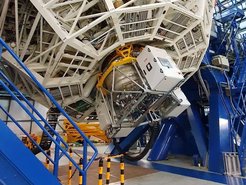ERIS
Latest news
Beginning of 2023: Start of routine science operations
February 2022: First light for ERIS
December 2021: Assembly, integration, and verification at Paranal Observatory has begun.
September 2021: ERIS successfully passed the Provisional Acceptance Europe review.

NACO and ERIS comparison of the inner ring of NGC 1097.
For more details visit https://www.eso.org/public/images/ann22015b

ERIS (Enhanced Resolution Imager and Spectrograph) is an instrument for diffraction limited imaging, coronagraphy and spectroscopy on the Cassegrain focus of VLT UT4 in the 1 to 5 µm spectral range to be commissioned in 2022. It will fully refurbish the existing integral field spectrograph SPIFFI and combine it with a new near infrared camera and a wavefront sensor module for the ESO adaptive-optics (AO) facility.
ESO has upgraded the VLT UT4 by an AO facility, which includes a deformable secondary mirror and four laser guide stars. Together with this exciting new facility, the existing instruments SINFONI and NACO are becoming obsolete. However, the high-spatial-resolution imaging and spectroscopy modes of NACO and SINFONI are indispensable for the VLT. Therefore, ESO decided to build the ERIS instrument, which makes use of the new AO facility and is composed of four main components:
- An upgraded version of SPIFFI with better throughput and higher spectral resolution
- A near-infrared camera called NIX to provide imaging in J-, H-, K-, L-, and M-bands, high-contrast imaging in L- and M-bands (K as a goal), and long-slit spectroscopy at a resolution of R ~ 800 in L-band
- A wavefront sensor module that uses the AOF and provides much higher strehl than currently available
- A calibration unit for spectral, spatial, and photometric calibration of all subsystems
The ERIS instrument thus provides similar functionality compared to NACO and SINFONI but significantly better performance, to last beyond 2030.
MPE has been involved in the project since the ERIS Phase A study. At the end of 2014, a consortium was formed under leadership of MPE to start the preliminary design phase of ERIS. Both ESO reviews during the development cycle of a VLT instrument have been successfully passed (Preliminary Design Review: 2016, Final Design Review 2017). Since then, the project has been proceeding through its manufacturing, assembly, and integration phase at all its consortium sites.
The final design of the instrument is presented in the figures below:




UT4 at the VLT. For more details visit https://www.mpe.mpg.de/7912661/news20221123
The responsibilities within the ERIS project and sub-systems are distributed among the consortium partners:
- Principle investigator (R. Davies), project management, system engineering: MPE
- SPIFFI upgrade to SPIFFIER: MPE
- Central mechanical structure, system electronics, and IR detectors: MPE
- NIX camera system: UK Astronomy Technology Centre in Edinburgh (ATC)
- NIX filter, pupil, and aperture wheels, including all filters and masks: ETH Zürich, NOVA (Leiden)
- Adaptive optics and warm optics: INAF-Arcetri
- Calibration unit: INAF-Teramo
- Instrument control software: INAF-Padua (lead) in collaboration with ATC and MPE
- Pipeline software: MPE (SPIFFIER), ATC (NIX)
- Wavefront sensor cameras, adaptive-optics real-time computer, detector procurement and testing, ERIS handling tool: ESO
Major schedule milestones for the ERIS project:
- End 2014: Formation of consortium
- Feb 2016: Preliminary design review
- Spring 2017: Final design review
- 2020: Integration at MPE
- Q1/Q2 2021: European acceptance
- Q1 2022: Begin of commissioning phase
- Q1 2023: Start of routine science operations

AO commissioning (extended objects).
Courtesy: Armando Riccardi (INAF)
Right: WinJUPOS map from Voyager-Galileo data
More information: ERIS first light paper
More information: ERIS at ESO
Picture credits: 1: ESO; 2, 3, 4, 5, 6: MPE






